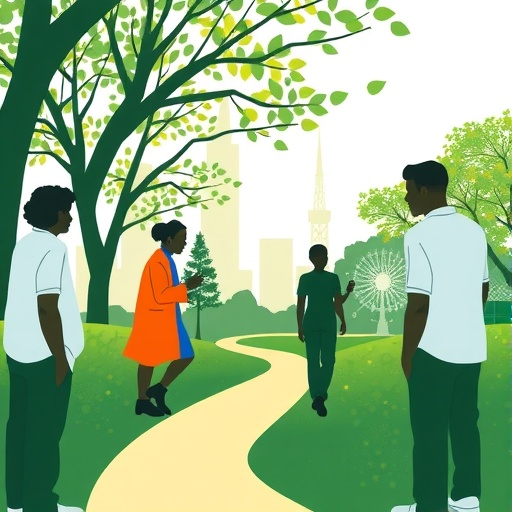In an era marked by persistent health inequities, the Transdisciplinary Research, Equity and Engagement (TREE) Center at the University of New Mexico (UNM) exemplifies a pioneering approach to dismantling systemic barriers through participatory, community-centered science. Featured prominently in the July 2025 supplement of Health Education & Behavior, the TREE Center’s innovative framework transcends conventional research paradigms by integrating academic rigor with deep community knowledge. This fusion cultivates interventions and insights that are not only culturally relevant but also structurally transformative in addressing health disparities.
At the core of the TREE Center’s impact is its commitment to transdisciplinary collaboration, which fosters an ecosystem where scholars, community members, and institutional stakeholders co-lead scientific endeavors. This model moves beyond unidirectional research dissemination, prioritizing bidirectional knowledge exchange that respects and elevates traditional wisdom alongside empirical inquiry. Such an approach has proven vital in developing nuanced strategies that resonate with diverse populations, including Tribal nations, Latinx communities, immigrant groups, and LGBTQ+ populations.
One of the most compelling dimensions of the TREE Center’s work lies in its multi-level interventions, which simultaneously address individual behaviors, community dynamics, and structural determinants of health. By anchoring initiatives in community priorities, TREE ensures interventions are not only theoretically sound but also pragmatically viable and sustainable. The center’s embrace of participatory methodologies has yielded programs that adapt fluidly to shifting social contexts, enhancing resilience among vulnerable populations.
Integral to TREE’s strategy is fostering the next generation of health equity scholars. The center actively mentors early-stage investigators, particularly those from historically underrepresented backgrounds, through leadership development and pilot funding opportunities. This investment cultivates a cadre of researchers equipped to navigate complex health disparities landscapes with cultural humility and scientific excellence, thereby extending TREE’s legacy beyond immediate projects.
TREE’s statewide partnerships encompass an impressive network of over 300 community entities, reflecting a commitment to inclusivity and scalability. The center’s infrastructure facilitates simultaneous engagement with localized health challenges and broader policy frameworks, exemplified by their research on immigrant mental health and the nuanced Latinx youth resilience. These collaborations underscore the center’s scalable model that leverages community assets to inform and transform health policies.
Translating research findings into actionable knowledge remains a hallmark of the TREE Center’s mission. Its innovative mechanisms for knowledge translation ensure that data-driven insights lead to tangible policy reforms and community empowerment. This cycle of evidence generation and application is crucial in overcoming entrenched disparities that traditional research models frequently overlook or inadequately address.
The integration of the National Institute on Minority Health and Health Disparities (NIMHD) framework into TREE’s operations further underscores the center’s strategic alignment with national health priorities. Emphasizing cultural relevance, co-leadership, and systems-level transformation, the framework buttresses TREE’s comprehensive approach to health equity. By operating within this structure, TREE amplifies the potential for sustainable, systemic change in marginalized communities.
An exemplary demonstration of TREE’s translational science is observed in its research on COVID-19 policy responses, especially among underserved populations. The center’s rapid deployment of participatory methods during the pandemic reveals the agility and responsiveness of its model—a crucial attribute in public health crises marked by fluid information landscapes and deep social inequities.
Collaborations with Tribal academic partners illuminate TREE’s dedication to honoring sovereignty and culturally embedded knowledge systems. These partnerships transcend extractionist research tendencies, fostering equal footing between academic and Tribal entities. The synthesis of modern scientific methodologies with Indigenous epistemologies enriches both partners’ understanding and cultivates interventions that are respectful, contextually aware, and more effective.
Critically, TREE’s financial support mechanisms, spanning over $763,000 in pilot project funding and grants from NIH institutes and philanthropic foundations, showcase a sustainable investment in equity-driven science. This funding diversity enables TREE to explore innovative, community-driven research avenues while maintaining rigorous scientific standards. Moreover, transparent disclosure of funding sources reflects the center’s commitment to maintaining ethical research practices.
As diversity, equity, and inclusion initiatives face mounting societal challenges, the TREE Center’s work stands as a testament to the power of collaborative, culturally centered research. Its innovative participatory team science model provides a roadmap for addressing complex health disparities through systemic, community-aligned interventions, reshaping the landscape of public health research and practice.
Ultimately, the TREE Center’s profound impact extends beyond scholarly publications to tangible improvements in health equity, resilience, and social justice. By co-creating knowledge with the communities it serves, TREE exemplifies how science can be both a tool for understanding and a catalyst for enduring societal transformation.
Subject of Research: People
Article Title: Community-Engaged, Participatory Team Science: The TREE Center’s Impact on Health Disparities Research and Health Equity
News Publication Date: 23-Jul-2025
Web References:
http://dx.doi.org/10.1177/10901981251348152
Keywords: Scientific community, Research programs, Health equity, Health disparity, Education




